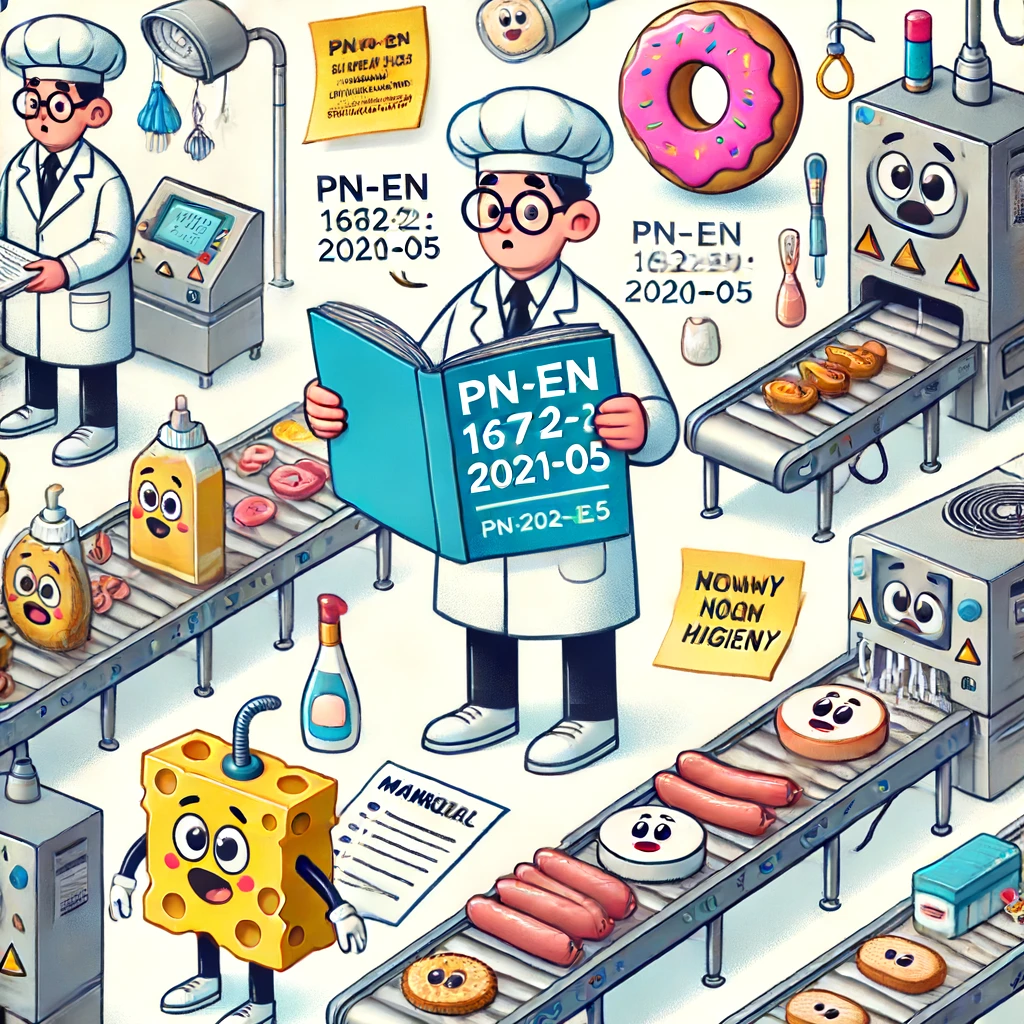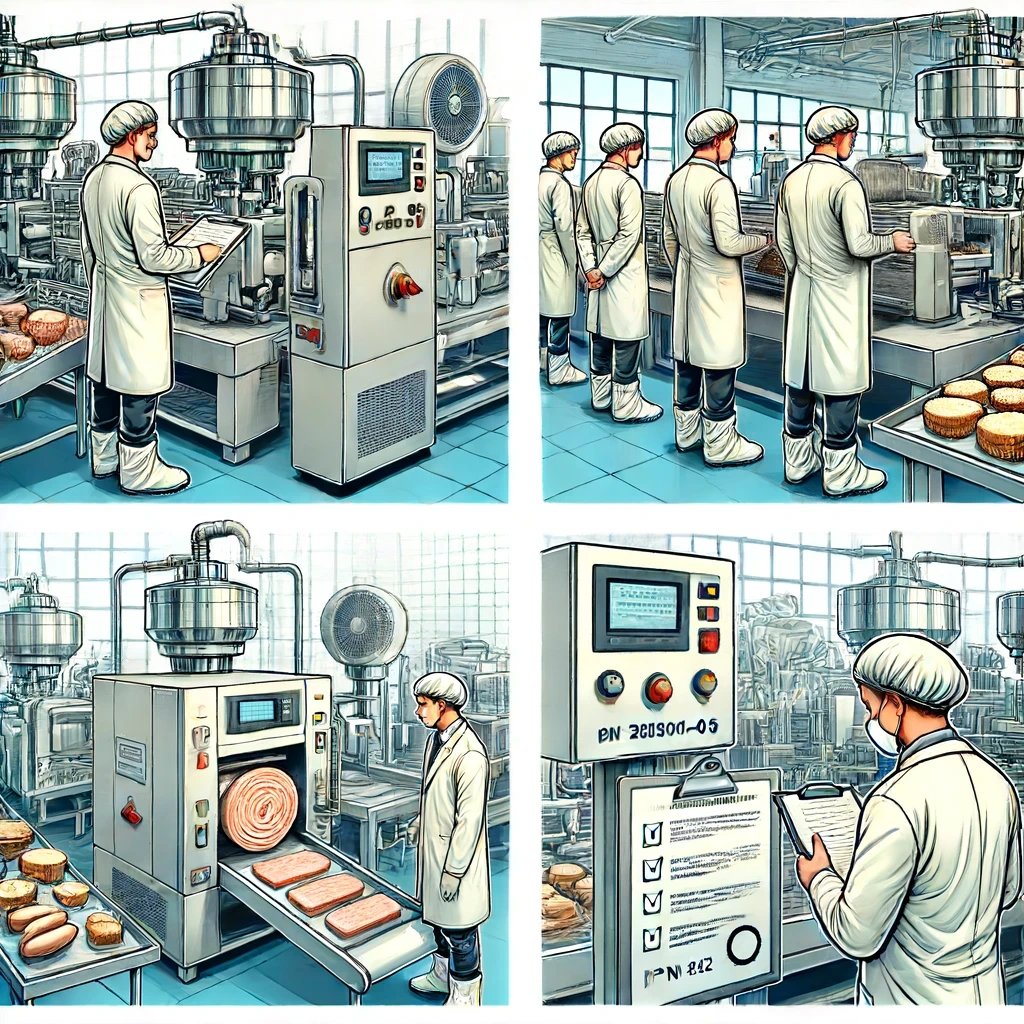Design of Food Processing Machinery according to PN-EN 1672-2:2021-05 is a specialized task crucial for maintaining hygiene and safety in the food industry. This standard, established by the European Committee for Standardization (CEN) and approved by the Polish Committee for Standardization (PKN), ensures that machinery used in food preparation and processing meets the highest hygiene standards, minimizing risks of contamination, infection, and injury.
Designing machinery according to this standard involves detailed requirements to ensure hygiene, ease of cleaning, and safety for both operators and consumers.
Table of Contents
Design of Food Processing Machinery according to PN-EN 1672-2:2021-05
Food Contact Surfaces
Surfaces in direct contact with food must be smooth, continuous, and easy to clean and disinfect. These surfaces should be free from cracks, crevices, and other areas where food residues and bacteria could accumulate. The surface finish should have a roughness Ra not exceeding 0.8 μm, although higher values are permissible if cleanliness can be assured.
| Category | Requirements |
|---|---|
| Hygiene | Food contact surfaces must be easy to clean and disinfect. |
| Materials | Use corrosion-resistant, non-toxic materials compliant with food safety regulations. |
| Construction | Design should minimize the risk of cross-contamination. |
| Safety | Equipment must include safeguards against mechanical and electrical injuries. |
| Documentation | Comprehensive instructions for use, maintenance, and cleaning. |
Surface Connections
Surface connections must be designed to minimize contamination risks. Continuous welding or sealed and flush joints are preferred.
Where removable connections are necessary, they must be easy to clean and ensure hygienic fitting upon reassembly.
Seals and Fasteners

Seals in food contact areas must be positioned to avoid uncleanable gaps. Fasteners like screws and nuts should be designed for easy cleaning, without open threads or gaps that could trap contaminants. Hexagonal head screws with flanges, dome nuts, or flanged screws are preferred.
Drains and Dead Spaces
Machinery should be designed to allow for self-draining of fluids (e.g., through appropriate slopes) or easy removal of fluid residues by other methods. Dead spaces where product residues or cleaning agents could accumulate should be eliminated or minimized.
Specific Material Requirements
Materials used in the construction of food processing machinery must be suitable for food contact. In food contact areas, materials must be:
- Corrosion-Resistant: Materials must withstand chemical agents and conditions of use to prevent corrosion.
- Non-Toxic: Materials must be non-toxic and not release harmful substances.
- Non-Absorbent: Materials must not absorb substances that could contaminate food.
Accessibility for Cleaning
Machine design must allow easy access to all surfaces requiring regular cleaning and maintenance. Machine components should be designed for easy disassembly without specialized tools.
Harmonization with Machinery Directive, GMP, and FDA
The PN-EN 1672-2:2021-05 standard is harmonized with the European Union’s Machinery Directive 2006/42/EC, meaning compliance with its requirements is recognized as meeting the directive’s requirements. Additionally, this standard aligns with Good Manufacturing Practices (GMP) and the U.S. Food and Drug Administration (FDA) guidelines in many areas.
GMP and FDA in Food Machinery Design
Designing food machinery according to GMP requirements includes:
- Hygiene Management: Machines must be designed to minimize food contamination risks, in line with GMP principles.
- Documentation and Procedures: Manufacturers must provide detailed operating instructions for cleaning, maintenance, and use, complying with GMP documentation and procedural requirements.
- Personnel Training: Personnel responsible for machine operation and maintenance must be adequately trained in hygiene and GMP procedures.
Compliance with FDA regulations means machines must meet the following requirements:
- Design and Construction: Machines must be designed and constructed from materials suitable for food contact, according to FDA regulations on food contact materials (21 CFR 174-178).
- Sanitation and Control: Machines must allow easy cleaning and disinfection, a key FDA requirement for sanitation and process control.
- Contamination Prevention: Machine design must prevent all forms of contamination, in line with FDA contamination prevention requirements.
Hygienic Risk Assessment Process
The standard introduces an iterative process for reducing hygienic risks, which includes the following steps:
- Hygienic Risk Assessment
- Hygienic risk analysis, including machine boundary identification, food safety hazard identification, and hygienic risk estimation.
- Hygienic risk assessment to determine if further risk reduction is necessary.
- Hygienic Risk Reduction
- Elimination of hygienic hazards or risk reduction through hygienic design.
- Risk reduction through technical measures.
- Risk reduction through cleaning and disinfection.
- Additional measures, if necessary, including personnel hygiene requirements and special training.
Risk Analysis according to PN-EN ISO 12100
Risk analysis according to PN-EN ISO 12100 involves identifying, assessing, and eliminating hazards associated with machinery. This process includes:
- Hazard Identification: Identifying all potential hazards that may occur during machine use.
- Risk Assessment: Evaluating the likelihood and potential consequences of hazards.
- Hazard Elimination: Implementing measures to eliminate hazards or reduce risk to an acceptable level.
Importance of Hygienic Design
Designing food machinery according to PN-EN 1672-2:2021-05 is crucial for ensuring that food products are processed safely and hygienically. Good design practices minimize food contamination risks, which is essential for consumer health protection.
Combined with GMP and FDA requirements, compliance with this standard ensures that machines meet the highest hygiene standards and comply with international regulations.

Industrial Automation and the Food Industry
Industrial automation plays a crucial role in the food industry, enhancing efficiency, quality, and safety in production processes. The integration of automated production processes allows precise control over production parameters, minimizing human error and increasing product consistency and quality. Using automation systems like Programmable Logic Controllers (PLC) enables flexible and rapid adaptation of production lines to changing market demands and product specifications. Automation in the food industry also involves the application of POKA-YOKE, Total Productive Maintenance (TPM), and Single-Minute Exchange of Die (SMED), which contribute to increased operational efficiency and reduced downtime. Advanced industrial automation allows achieving high Overall Equipment Effectiveness (OEE) and Key Performance Indicators (KPI), resulting in better control over food production quality and safety. CE certification of machinery and compliance with harmonized standards, such as PN-EN 1672-2:2021-05, are essential to ensure that automated systems meet the highest hygiene standards and are safe for users. Automation of production processes not only increases the competitiveness of food enterprises but also contributes to consumer health protection by ensuring that products are manufactured safely and hygienically.
More on PN-EN 1672-2
PN-EN 1672-2:2021-05 provides comprehensive guidelines for designing food machinery that must be hygienic, easy to clean, and safe for users and consumers. Meeting these requirements is crucial for ensuring food safety and compliance with legal regulations such as the Machinery Directive 2006/42/EC, GMP, and FDA. With detailed requirements for materials, surfaces, connections, seals, and construction, this standard is the foundation of hygiene in the food industry.
PN-EN 1672-2:2021-05 is an essential document for anyone involved in designing food machinery, ensuring that production processes comply with the highest hygiene standards. By meeting the design requirements, manufacturers can ensure food safety and compliance with international regulations, which is crucial for success in the food industry.
FAQ: Design of Food Processing Machinery
PN-EN 1672-2:2021-05 is a document regulating hygiene standards and cleaning capabilities of machinery used in the food industry. It was developed by the European Committee for Standardization (CEN) and approved by the Polish Committee for Standardization (PKN).
Food contact surfaces must be smooth, continuous, and easy to clean and disinfect. They should be free from cracks, crevices, and other areas where food residues and bacteria could accumulate.
Surface connections are where different parts of the machine join together. They must be designed to minimize contamination risks, preferring continuous welds or sealed joints.
Materials must be corrosion-resistant, non-toxic, and non-absorbent to prevent retaining substances that could contaminate food.
Industrial automation involves control and monitoring systems for production processes. In the food industry, it increases efficiency, safety, and quality by precisely controlling production parameters.
PN-EN 1672-2:2021-05 is aligned with the Machinery Directive 2006/42/EC, meaning compliance with its requirements is recognized as meeting the directive’s requirements, enabling CE marking of machines.
GMP requirements include hygiene management, documentation and cleaning procedures, and training personnel in machine hygiene and maintenance.
Risk analysis according to PN-EN ISO 12100 is a process of identifying, assessing, and eliminating hazards associated with machinery to ensure user and consumer safety.
FDA requirements include designing and constructing machines from materials suitable for food contact, enabling easy cleaning and disinfection, and preventing contamination.
Industrial automation allows precise control of production processes, minimizing human error, increasing product consistency and quality, and ensuring compliance with hygiene and safety standards.
